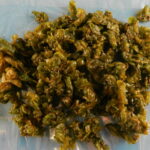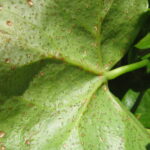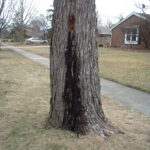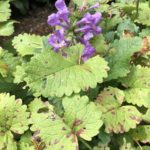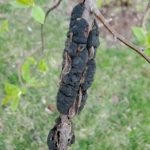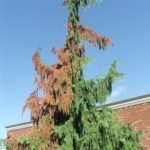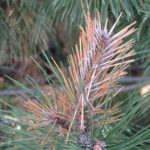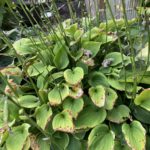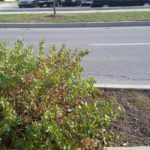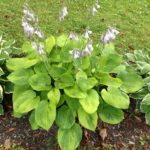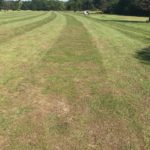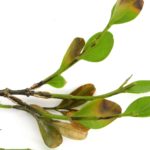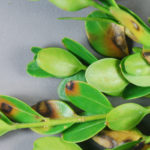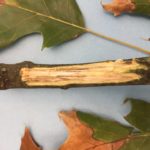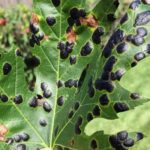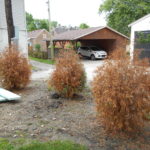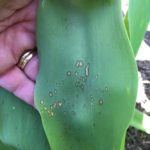This very slimy substance (Fig. 1) has many common names, was once classified as an algae but is now known as a Cyanobacterium. It is worse in areas that are frequently wet, such as low areas in lawns or on frequently irrigated golf courses (Fig. 2) or along walkways in nurseries where it can create[Read More…]
This spring the PPDL received several samples, calls and emails related to dying weeping cherry trees (Fig. 1, 2, 3). Reports of this phenomenon came from as far away as Missouri. Ornamental cherry trees (and related Prunus spp.) are susceptible to multiple problems, including southwest injury (Fig. 4) Botryosphaeria dieback/canker (Fig. 5), bacterial canker and[Read More…]
Plants that experience extremes in soil moisture may develop spots on their leaves, called “oedema” (also spelled “edema”). The spots may first appear as a blister or raised spot, particularly on the undersides of leaves, but may occur on the top side as well as on the stems. Eventually, the blister develops a rust-colored, cork-like[Read More…]
Slime flux (also known as wet wood) is a dark, foul-smelling and unsightly seepage of sap from tree trunks (fig. 1). The disease is not usually a serious problem but the appearance can be alarming. Slime flux is caused by common surface-inhabiting bacteria or yeast fungi that enter the trunk through wounds associated with improper[Read More…]
Earthworms are not the only wigglers in the soil beneath your feet. Nematodes, microscopic roundworms, can be found in soil across the globe (even Antarctica!) and are often a barometer of soil and environmental health. However, the nematodes we encounter more frequently feed on plants and cause us, as plant stock producers and consumers, a[Read More…]
Black knot, caused by the fungus Apiosporina morbosa, is a recurring problem on Prunus species. Most Indiana fruit growers, both professional and amateur, have at one time or another observed the black, knot-like warty growths (Fig. 1) that often occur on the woody parts of plum and cherry trees. This fungal disease is one of[Read More…]
Day-to-day activities have changed every aspect of businesses throughout the country. The Green Industry is no exception, with changes implemented to maintain safe working environments for employees and their clients while being compliant with the state’s Executive Order. Due to the diversity of services and products that the Green Industry provides, there is no one-size-fits-all[Read More…]
This Nootka falsecypress (Chamaecyparis nootkatensis) is showing severe dieback throughout much of the tree (fig. 1 and 2). The primary pathogen present is a fungus in the genus Diplodia. Small twigs are infected first, which eventually leads to dieback of larger branches (fig. 3). Note the spherical black spore bearing structures (pycnidia) at the base[Read More…]
The dead lower branches in these Austrian pines (Fig. 1) are due to Diplodia (= Sphaeropsis) tip blight. The causal fungus infects newly elongating shoots, in late spring, resulting in stunting and death of the new growth (Fig. 2). Black spore-bearing structures of the causal fungus are formed at the base of the stunted brown[Read More…]
If your hostas are looking a little ratty recently you’re not alone (all the photos here are from my garden). Hostas at this time of year tend to have marginal scorch, dieback, leaf spotting and yellowing . A variety of factors may contribute to these symptoms including environment, diseases and insect pests. Anthracnose, caused by[Read More…]
Fragrant sumac (Rhus aromatica) is a low growing native shrub that is valued for its adaptability to many soil types, wet or dry conditions, easy care as a ground cover, and for preventing erosion on slopes. It is often found in highway medians (Fig. 1), in parks or as a foundation planting around commercial buildings.[Read More…]
Hosta Virus X (HVX) is not a new problem, however, it’s not as prevalent as it was nearly a decade ago because growers have gotten better about recognizing the disease and removing infected plants from their nurseries. The most common symptoms include mottled, light or dark green discolorations along leaf veins (Fig 1). HVX may[Read More…]
Hakone grass (Hakonechloa macra), also known as Japanese forest grass, is often used for massing in beds in where a low maintenance ground cover is needed in semi-shaded areas. The graceful arching stems along with the availability of gold or white striped variegated cultivars make it an attractive option. There are few reports of disease[Read More…]
A look back at the past year may help us be alert to problems ahead. Here’s a summary of the most common problems received in the diagnostic lab on woody ornamentals in 2018. As is typical for most years there were more non-disease (abiotic) problems than infectious (biotic) diseases found on PPDL lab samples in[Read More…]
The DNR Division of Entomology & Plant Pathology has discovered that a shipment of boxwood plants infected with boxwood blight was shipped to Indiana in May. This is important because boxwood blight (Calonectria pseudonaviculata) is a fungal disease that infests members of the popular Buxaceae family, and is often transported through the nursery trade. Hosts[Read More…]
Getting calls from panicked customers about black spots on maple leaves? You’re probably not alone, because now is the time when people start to notice maple tar spot. Every summer we get questions about black spots on maple leaves that look like tar. These spots are not actually “tar” on maple, but are rather a[Read More…]
Arborvitae varieties (Thuja spp.) provide some of our most beautiful and versatile evergreens for landscapes, with an extensive selection of sizes and types. Unless they get proper care, they also give us some frustrating failures. Here is my list of the most frequently encountered ‘Arborvitae Aggravations’, based on the samples and questions we get in[Read More…]
The recent jump from Winter to Summer (with 2-3 days of Spring somewhere in there) got folks out looking at Tulips in full bloom now in northern Indiana. The only thing marring the view in one local planting was an outbreak of tulip fire, caused by the fungus Botrytis tulipae. The disease first shows up[Read More…]

